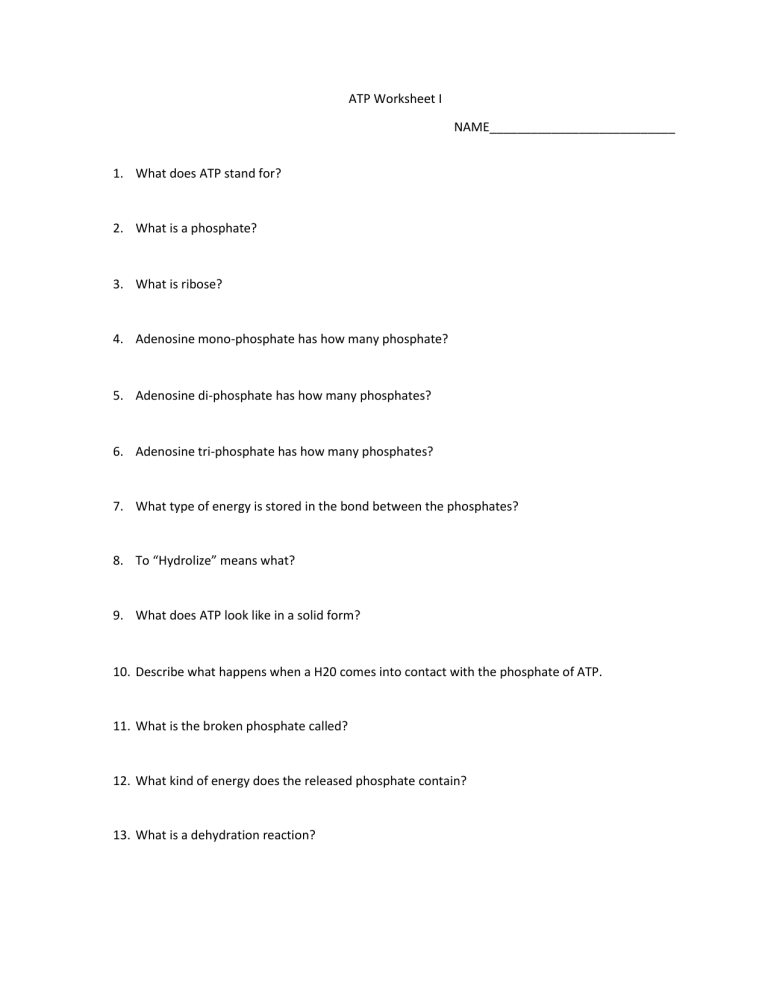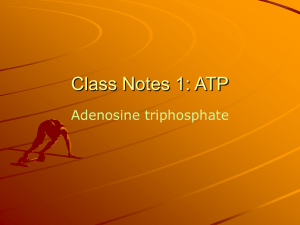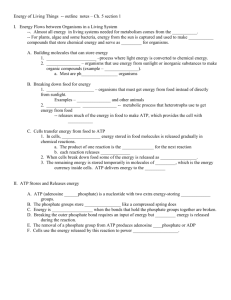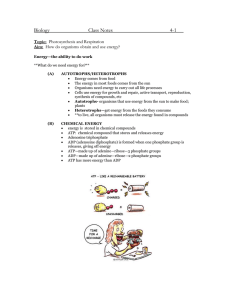ATP Worksheet
advertisement

ATP Worksheet I NAME___________________________ 1. What does ATP stand for? 2. What is a phosphate? 3. What is ribose? 4. Adenosine mono-phosphate has how many phosphate? 5. Adenosine di-phosphate has how many phosphates? 6. Adenosine tri-phosphate has how many phosphates? 7. What type of energy is stored in the bond between the phosphates? 8. To “Hydrolize” means what? 9. What does ATP look like in a solid form? 10. Describe what happens when a H20 comes into contact with the phosphate of ATP. 11. What is the broken phosphate called? 12. What kind of energy does the released phosphate contain? 13. What is a dehydration reaction? 14. Loose phosphates (hydrolyzed) are like what? 15. What are two ways that energy is reintroduced to a detatched phosphate, to reattach it to the Adenosine Diphosphate? 16. What does the ATP Synthaze do? 17. What is the overall reaction catalyzed by ATP synthase? 18. Why does ATP creation require the ATP Synthase enzyme? 19. What is an electrochemical gradient and how does it produce active transport? 20. Once ATP gives up its phosphate, where does it go? 21. Once the phosphate binds with the pump, what does it do? 22. How much energy is spent creating ATP in your body? 23. How do our muscles move? 24. What is LUCA 25. What did LUCA and henceforth all cells contain? 26. What processes in the cell are powered by ATP? Adenosine Triphosphate Adenine is Carbon + Nitrogen (Nitrogenous base, as in the rungs on DNA) Ribose is Sugar Together Adenine and Ribose form Adenosine 2. Phosphate is Phosphorous surrounded by oxygen. 7. Potential energy 8. The bonds break down in water. Water breaks the last phosphate group. 9. Salt 10. The phosphate breaks away: One Hydrogen Atom attaches to the broken phosphate, another attaches to the still connected phosphate, and the Oxygen (of H20) is released. 11. Pi 12. Potential 12. When the phosphate (Pi) reattaches to the ADP (2), forming ATP (3) again. 15. A battery that has lost its charge 16. Respiration, in which glucose is broken down. Photosynthesis, in which energy is gained from the sun. Each of these is a dehydration reaction, which reattaches the Phosphate to the Adenosine. 17. Create the energy storage molecule ATP 18. ADP + Pi + H+ out ⇌ ATP + H2O + H+ in 19. The formation of ATP from ADP and Pi is energetically unfavorable (unstable) and would normally happen in reverse. 20. Chemical gradient on one side of a cell membrane, and an electrical gradient on the other. When there are unequal concentrations of an ion across a permeable membrane, the ion will move across the membrane from a level of higher concentration to lower through diffusion. The difference in charge between each side of the membrane creates a force that moves the ions to balance the charge on each side. 21. It binds with the sodium-potassium pump lodged in the cell membrane. 22. It uses the energy of the phosphate to pump three sodium ions out, onto the other side of the cell membrane. Potassium is pumped in. 23. 20 percent of the energy in your body is creating ATP and running the sodium potassium pump in your mitochondria. 24. Myosin in the muscles is attracted to an actin through the phosphate released from ATP. 25. Last Universal Common Ancestor 26. ATP, RNA, DNA, Glucose, Proteins, Ribosomes, Membranes, Ion Channels





